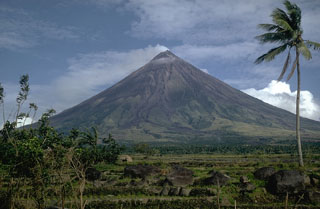Report on Mayon (Philippines) — 4 October-10 October 2023
Smithsonian Institution / US Geological Survey
Weekly Volcanic Activity Report, 4 October-10 October 2023
Managing Editor: Sally Sennert.
Please cite this report as:
Global Volcanism Program, 2023. Report on Mayon (Philippines) (Sennert, S, ed.). Weekly Volcanic Activity Report, 4 October-10 October 2023. Smithsonian Institution and US Geological Survey.
Mayon
Philippines
13.257°N, 123.685°E; summit elev. 2462 m
All times are local (unless otherwise noted)
PHIVOLCS reported that slow lava effusion at Mayon’s summit crater continued during 3-10 October. The lengths of the lava flow in the Mi-Isi (S), Bonga (SE), and Basud (E) drainages remained at 2.8 km, 3.4 km, and 1.1 km, respectively. Collapses at the lava dome and from the margins of the lava flows produced incandescent rockfalls and occasional pyroclastic density currents (PDCs, or pyroclastic flows) that descended the flanks as far as 4 km. Each day seismic stations recorded 92-180 rockfall events, 0-6 PDC events, and 4-30 daily volcanic earthquakes. Sulfur dioxide emissions measured almost daily averaged between 690 and 1,969 tonnes per day, with the highest value recorded on 3 October. The Alert Level remained at 3 (on a 0-5 scale) and residents were reminded to stay away from the 6-km-radius Permanent Danger Zone (PDZ). PHIVOLCS recommended that civil aviation authorities advise pilots to avoid flying close to the summit.
Geological Summary. Symmetrical Mayon, which rises above the Albay Gulf NW of Legazpi City, is the most active volcano of the Philippines. The steep upper slopes are capped by a small summit crater. Recorded eruptions since 1616 CE range from Strombolian to basaltic Plinian, with cyclical activity beginning with basaltic eruptions, followed by longer periods of andesitic lava flows. Eruptions occur predominately from the central conduit and have also produced lava flows that travel far down the flanks. Pyroclastic density currents and mudflows have commonly swept down many of the approximately 40 ravines that radiate from the summit and have often damaged populated lowland areas. A violent eruption in 1814 killed more than 1,200 people and devastated several towns.
Source: Philippine Institute of Volcanology and Seismology (PHIVOLCS)

